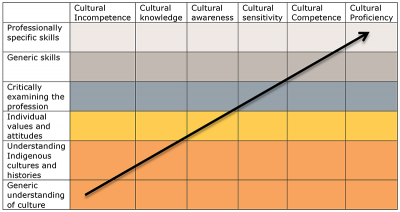IND/What is Cultural Competence?
- Knowledge: an ability to be aware that all people, societies and institutions have culture, that culture manifests itself in certain ways and that cultures interact relative to each other;
- Knowledge: of Indigenous cultural practices, cultural change and Australia’s history and the relative power positions of mainstream and Indigenous cultures;
- Values: a recognition that there are several ways to construct the world and meaning within it, and that there may be more than one ‘truth’ or ‘right way’;
- Attitude: a willingness to critically reflect on inter-cultural interactions and learn from them;
- Skills: a range of communication, behavioural and professional skills and interaction strategies that can be called on in different circumstances.
Cultural competence can be graphed, as below, however the journey is not always a smooth upward line! Reflective practice is a useful skill to develop, in which you look back on your practice and consider alternative ways you could do things to achieve better outcomes. What you actually consider will be dependent on your particular field. You should be provided with the opportunity to consider what this means for you in your profession later in your course.
Exploring Your Own Cultural Competence
Some of you may be wondering why it is necessary for you to have an understanding of cultural competence. For example, your if future profession means that you may have limited or no contact with Indigenous students/clients/patients. However, many of you will be entering the teaching profession and some of you will work in areas which have a high Indigenous Australian population. You may obtain employment in an Indigenous organisation or community. Or you may be asked to take part in a research project which involves Indigenous people. Wherever you work, some of your colleagues may be Indigenous.
Cultural competence is also considered a strategy to ‘close the gap’ in Indigenous disadvantage. Some of you may consider this an important element in your lives and work.
